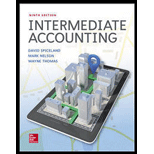
Judgment Case 8–3
The specific identification inventory method; inventoriable costs
• LO8–3, LO8–4
Happlia Co. imports household appliances. Each model has many variations and each unit has an identification number. Happlia pays all costs for getting the goods from the port to its central warehouse in Des Moines. After repackaging, the goods are consigned to retailers. A retailer makes a sale, simultaneously buys the appliance from Happlia, and pays the balance due within one week.
To alleviate the overstocking of refrigerators at a Minneapolis retailer, some were reshipped to a Kansas City retailer where they were still held in inventory at December 31, 2018. Happlia paid the costs of this reshipment. Happlia uses the specific identification inventory costing method.
Required:
- 1. In regard to the specific identification inventory costing method:
- a. Describe its key elements.
- b. Discuss why it is appropriate for Happlia to use this method.
- 2. a. What general criteria should Happlia use to determine inventory carrying amounts at December 31, 2018?
b. Give four examples of costs included in these inventory carrying amounts.
- 3. What costs should be reported in Happlia’s 2018 income statement? Ignore lower of cost or market considerations.
Want to see the full answer?
Check out a sample textbook solution
Chapter 8 Solutions
INTERMEDIATE ACCOUNTING (LL) W/CONNECT
- Please provide the solution to this general accounting question with accurate financial calculations.arrow_forwardI need guidance with this general accounting problem using the right accounting principles.arrow_forwardHow can I solve this financial accounting problem using the appropriate financial process?arrow_forward
- Transactions: Dec. 3 Wrote off Langston Corporation’s past-due account as uncollectible, $645.75. M203. 9 Accepted a 90-day, 8% note from Farris Company for an extension of time on its account, $2,400.00. NR23. 18 Received cash from Storage Solutions for the maturity value of NR19, a 90-day, 9% note for $2,000.00. R455. 21 Coastal Supply dishonored NR21, a 90-day, 8% note, for $3,000.00. M245. 30 Received cash in full payment of Langston Corporation’s account, previously written off as uncollectible, $645.75. M232 and R463. Task 1 Journalize the transactions for Miller Corporation in Questions Assets that were completed during December of the current year. Use page 12 of the general journal and page 12 of the cash receipts journal. Task 2 Post each entry to the general ledger and to the customer accounts in the accounts receivable ledger. You will not need to make entries to the Item columns of the ledgers. Task 3 Continue to…arrow_forwardE-M:11-18 Using payback to make capital investment decisions Consider the following three projects. All three have an initial investment of $600,000. Net Cash Inflows Year Project L Project M Project N Annual Accumulated Annual Accumulated Annual Accumulated 1 $ 150,000 $ 150,000 $ 100,000 $ 100,000 $ 300,000 $300,000 2 150,000 300,000 200,000 300,000 300,000 600,000 3 150,000 450,000 300,000 600,000 4 150,000 600,000 400,000 1,000,000 5 150,000 750,000 500,000 1,500,000 6 150,000 900,000 7 150,000 1,050,000 8 150,000 1,200,000 1. Determine the payback period of each project. Rank the projects from most desirable to least desirable based on payback. 2. Are there other factors that should be considered in addition to the payback period?arrow_forwardKindly help me with this General accounting questions not use chart gpt please fast given solutionarrow_forward
- Horngren's Financial & Managerial Accounting: The Managerial Chapters, 8th Edition E-M:10-12 Making pricing decisions Sufyan Builders builds 1,500-square-foot starter tract homes in the fast-growing suburbs of Atlanta. Competition among developers is fierce. The homes are a standard model, with any upgrades added by the buyer after the sale. Sufyan Builders’ costs per developed sublot are as follows:Land $ 59,000Construction 124,000Landscaping 6,000Variable selling costs 5,000 Sufyan Builders would like to earn a profit of 14% of the variable cost of each home sold. Similar homes offered by competing builders sell for $208,000 each. Assume the company has no fixed costs. Questions:1. Which approach to pricing should Sufyan Builders emphasize? Why? 2. Will Sufyan Builders be able to achieve its target profit levels? 3. Bathrooms and kitchens are typically the most important selling features of a home. Sufyan Builders could…arrow_forwardCan you provide a detailed solution to this financial accounting problem using proper principles?arrow_forwardPlease explain the solution to this general accounting problem with accurate explanations.arrow_forward
 Intermediate Accounting: Reporting And AnalysisAccountingISBN:9781337788281Author:James M. Wahlen, Jefferson P. Jones, Donald PagachPublisher:Cengage Learning
Intermediate Accounting: Reporting And AnalysisAccountingISBN:9781337788281Author:James M. Wahlen, Jefferson P. Jones, Donald PagachPublisher:Cengage Learning
